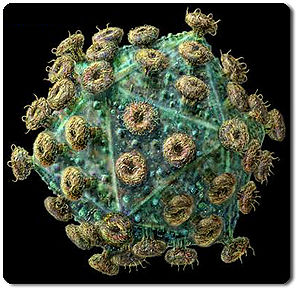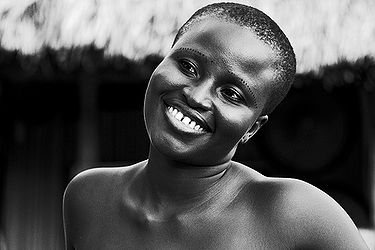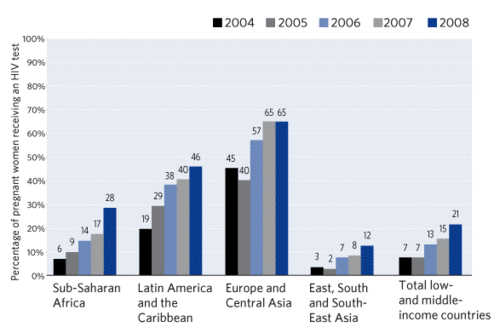HIV/AIDS and Women's Health
Introduction
Kirkley Doyle Kenyon '13
HIV/AIDS is the single most challenging aspect of global health in our lifetimes. HIV/AIDS is a complex virus with five major strains that affect the human population all over the world. There is no cure for HIV/AIDS and it affects an incredibly large percentage of the population. Estimated by the Center for Disease Control, at the end of 2006 1,106,400 persons in the United States were living with HIV infection. And, in 2008 the Center for Disease Control estimated approximately 56,300 people became infected with HIV/AIDS in 2006[6]. HIV/AIDS is a hugely complex health issue for everyone, but women around the world especially those living in poverty stricken third world countries deal with some unique health issues around HIV/AIDS. Women living in many third world countries are uneducated, marginalized and undervalued compared to men. Women have limited power and sometimes no control over their bodies. The social hierarchy places women in an emotionally and physically weakened state where they are more vulnerable to sexual violence and ultimately HIV/AIDS.
Viral Structure
Human Immunodeficiency Virus or HIV/AIDS (Acquired Immunodeficiency Virus-a later developed stage of the virus) is a retrovirus, illustrated in Fig. 1. The virus has RNA genome which is transcribed into DNA through the process of reverse transcriptase. The DNA then enters the nucleus of healthy human cells and diverts the cell’s processes to continually make more virus particles. HIV is transmitted from host to host through bodily fluids-blood, breast milk, and sexual fluids. Direct blood to blood contact has a 90% transmission rate, pregnancy-mother to child while the child is in the uterus has a 50% transmission rate, breast milk ingested by an infant has a 10% transmission rate, insertive intercourse has a 1% transmission rate, receptive intercourse has a .1% transmission rate and oral contact has an extremely low transmission rate. HIV binds to CD4 receptors on T cells in the immune system, so slowly over time the virus attacks the entire immune system. Once the T cell count gets below a certain number, the virus is called AIDS. While the immune system is weakened by the virus, the body develops what are called opportunistic infections-ailments that occur because the weakened immune system cannot fight them off. The individual infected with HIV/AIDS dies eventually from the opportunistic infections instead of the virus itself. Opportunistic infections can be anything from yeast infections to influenza or deadly killing diseases like tuberculosis[4].

HIV/AIDS and Women
“The World Health Organization said that the AIDS virus is the leading cause of death and disease among women between the ages of 15 and 44"[3]. HIV/AIDS among women in third world countries is such a huge problem for many reasons-physical aspects of viral transmission, lack of health care and protective sexual barriers and women’s placement in the global social hierarchy-underneath men. In much of the third world, girls and women are uneducated, undervalued and controlled by men. Sexual crimes and rape are often used to keep women in their place and such crimes are large contributors to disease spread especially HIV/AIDS. According to the U.N. agency, one in five deaths among women between the ages of 15 and 44 is linked to unsafe sex[3]. Unprotected sex is very dangerous as far as disease prevention, especially for women and when concerning HIV/AIDS. Vaginal tissues are extremely thin and sensitive. During sexual intercourse it is common for the tissues to have small breakages, which can cause women to contract sexually transmitted diseases and infections easily through unprotected sex. When a man, infected with HIV/AIDS, penetrates a woman’s vagina with his penis and there is no use of a sexual barrier, the chance of transmission is 1%. However, when a man penetrates a woman’s vagina with no use of sexual barrier and she is infected with HIV/AIDS the transmission rate is .1%. It is much more likely that a woman will contract especially HIV/AIDS but also other sexually transmitted diseases or infections from unprotected sex than a man.
HIV/AIDS, Women and Economics
Because women are grossly undereducated compared to men, their opportunities for earning money are extremely limited. If a woman’s male partner dies, especially a woman infected with HIV/AIDS, she will most likely lose all of her possessions and sometimes her children. She will likely have little education and no choice [2]. Often times women turn to prostitution as the only means of survival available to them, and they do not understand the risks of unprotected sex and the high disease contraction rates that prostitution poses. The prostitution industry is a major contributor to HIV/AIDS transmission. A lot of the time, many women have only prostitution to turn to as a means to support themselves and their families and they are uneducated about the risk of HIV/AIDS. Prostitution is dangerous as far as disease control because of high numbers of sexual partners but also lack of protection, and often times forceful or violent sexual intercourse. Many modern brothels, pimps and prostitutes themselves do not insist upon condom use-the client will pay more if he does not have to wear a condom. And, the women do not tell anyone about the violence that happens in their jobs in fear of losing their job.
Violence Against Women and HIV/AIDS
Violence against women is a huge issue worldwide. Women who are in an unbalanced and unequal or abusive relationship with a man are at heightened risk of contracting HIV/AIDS, and other possible opportunistic infections. Women who live in fear of violence are physically and emotionally unhealthy. They have no power to insist condom use during sexual intercourse, and in the case of forced sexual intercourse HIV/AIDS transmission spikes because of tears or lacerations in vaginal tissues[2]. Women who live in a culture that supports or allows men to take multiple wives or sexual partners have to deal with ultimate sexual submission, and when it is crucial that a barrier is used in sexual intercourse, most of the time it is not-the men do not want to. When women are in a position where men have complete control over their bodies and they have no voice or power to protect themselves, it creates a ripe environment for an epidemic like HIV/AIDS to occur.
HIV/AIDS Treatment and Testing in Women
Many women living in cultures where men are in control have trouble seeking treatment and health care. Many times women have responsibilities to care for children and do housework and they cannot leave their duties to acquire healthcare, or their husbands will be unhappy. And, many women cannot even leave their houses to seek healthcare without a husband, father or brother, and men often work during the day anyway and cannot accompany women to the doctor.
Women living in poor lower economic countries are generally under the control of the men in their lives and they do not have jobs of their own outside of the household. Women often do not have control over household funds and cannot afford treatment, medication, or even preventative barriers[2]. It is not a case by case issue of women dealing with abusive husbands, many cultures simply value the needs and lives of men over women. Women living in countries where the are undervalued compared to men are likely to receive unequal health care compared to men from infancy[3]. They also tend to receive less education than men. Many women contract HIV/AIDS and opportunistic infections because they simply do not understand HIV/AIDS and how to protect themselves.
United Nations General Assembly Special Session on HIV/AIDS (UNGASS) set out in 2001 to set up policy around gender equality pertaining to treatment and testing in the HIV/AIDS epidemic. They requested data from many countries and 147 reported. The results were out of 147 total countries reporting national data, 78% of the countries reported relevant UNGASS data that indicated that their HIV/AIDS programs or actions were somewhat or completely sex segregated. This data is testimony to the unequal care and treatment of women in the HIV/AIDS epidemic, and it should not be. Whether treatment and testing are available to someone who is HIV/AIDS positive should not be decided on the basis of gender[5].
HIV/AIDS is very stigmatized. In many cultures it is very shameful to have the disease and people do not want to get tested, because they do not want to deal with their communities knowing they have the disease. People live with HIV/AIDS for long periods of time to avoid getting tested. HIV/AIDS is thought of as a dirty disease because the ways to contract it. Blood contact, needle sharing and unprotected sex are thought of as promiscuous behaviors and are not tolerated by communities and families. Women especially do not want to get tested because if they have positive results for HIV/AIDS they will likely face violence from their husbands, disownment by their families and then they are left deserted with very few options. As seen in Fig. 2. testing for HIV among women is much less likely in third world countries where women experience more inequalities around healthcare and HIV. A survey conducted in Guayaquil, Ecuador in 2006 by the University of Connecticut School of Medicine invited pregnant women to come in for HIV testing. They found that many of the women had been tested for HIV before, and that women who perceived personal risk around HIV/AIDS were almost twice as likely to get tested. The educational level of the pregnant women, their knowledge of HIV/AIDS, directly affected whether they got tested. It was suggested in the study that prenatal care should include include accurate education about perceived personal risk. If women are educated about HIV/AIDS they will be more likely to have safe and protected sex, get tested for HIV and seek better prenatal care for their children. Educating women is a huge step in stopping the transmission of HIV/AIDS[1].
As you can demonstrated in the graph, the percentage of women who received HIV/AIDS testing while they were pregnant increased as the income level of the country increased, and presumably the educational level of the women.
HIV/AIDS and Pregnancy in Women
Women also have the additional concern of transferring the virus to their unborn children during pregnancy. Since many women do not have access to contraceptives or cannot convince their partner to use a barrier, they are both unprotected from disease but also pregnancy. HIV/AIDS can be transmitted through blood and breast milk. The child could be infected in the womb from blood transmission through the umbilical chord or from continual breast feeding after birth. Many women in third world countries have no other option but to breast feed their infants because they have no access to formula or clean water, so transmission to their infants is nearly inevitable.
What is being done to help
There are many programs currently with a focus on the important issues that women living with HIV/AIDS face. The MTCT(Mother-To-Child-Transmission)-Plus is an initiative that was established in 2002. MCTC-Plus works in coordination with Columbia University not only to prevent transmission of HIV to infants but to help mothers living with HIV/AIDS, their children and their partners. The initiative provides medications, funding for operations, and education around HIV/AIDS [7]. Another program devoted to helping women living with HIV/AIDS is Project TEACH. Project TEACH is a program that is devoted to changing education about HIV/AIDS to be directed to a wider audience including women and the special issues they face [8]. Everyone needs to be educated about HIV/AIDS and everything that could possibly affect them. This includes issues of breast feeding, mother-to-child-transmission and other biological differences between men and women around HIV/AIDS. These are just two programs that are dedicated to helping women living with HIV/AIDS, there are many more programs out there helping.
Conclusion

Chief of the world health organization, Dr. Margaret Chan stated “We will not see a significant improvement in the health of women until they are no longer recognized as second-class citizens in many parts of the world”[3]. Empowering and educating women is vital in helping to end the AIDS epidemic. When women are equal to the men in their lives, they can insist protection during sexual intercourse, leave abusive relationships where their health is at risk and receive equal education and job opportunity. It is important to empower women to protect themselves and their children against HIV. In an ancient chinese saying is states that “women hold up half the sky” and it is time that women are treated equally for women are the mothers of the future.
References
4. [Class notes]
Edited by student of Joan Slonczewski for BIOL 191 Microbiology, 2009, Kenyon College.

